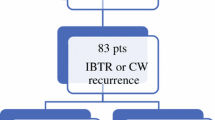Abstract
Introduction The usefulness of routine axillary dissection (AD) at levels I–II in breast cancer patients has been questioned for years because of the high postoperative morbidity in the shoulder and arm region, and the increasing number of patients with negative nodes. Sentinel node biopsy (SNB) was hoped both to reduce morbidity and to improve the reliability of staging. This study was designed to provide more evidence in this matter by comparing the follow-up data of patients with AD and those with SNB only.
Method One hundred forty patients who had undergone AD between 1993 and 1996 were questioned for their subjective and objective symptoms using a questionnaire and subsequently subjected to a clinical examination. Their data were compared with those of 57 patients who had undergone SNB only between 1998 and 2000.
Results Local recurrences have not been seen to date. The difference between the two groups in terms of a loss of quality of life was negligible. The differences in overall complaints, number of symptoms, pain, limited range of motion of the operated upper extremity, numbness, paresthesias, and arm swelling as well as perceived disability in activities of daily living were significantly in favor of SNB. The length of hospital stay was significantly shorter for SNB patients.
Conclusion SNB appears to be an accurate procedure for axillary nodal staging in breast cancer patients and is associated with reduced postoperative morbidity and length of hospital stay. But it is still investigational and should not be implemented as therapeutical standard before results of randomized trials are published.
Similar content being viewed by others
References
Giuliano AE, Kirgan DM, Guenther MJ, Morton DL: Lymphatic mapping and sentinel lymphadenectomy for breast cancer. Ann Surg 220(3): 391–401, 1994
Giuliano AE, Dale PS, Turner RR, Morton DL, Evans Sheila W, Krasne DL: Improved axillary staging of breast cancer with sentinel lymphadenectomy. Ann Surg 222(3): 394–401, 1995
Haid A, Fritzsche H, Peschina W, Gruber-Mösenbacher U, Jasarevic S, Hillbrand E, Köberle-Wührer R, Müller G, Schmidle T, Breitfellner G: Die Sentinel-Node-Biopsy beim Mammakarzinom: ein minimal invasives Verfahren zum exakten Staging der Axilla. Wien Klin Wochenschr111/6: 219–225, 1999
Veronesi U, Paganelli G, Viale G, Galimberti V, Luini A, Zurrida S, Robertson C, Orvieto E, De Cicco C, Intra M, Tosi G, Scarpa D: Sentinel node biopsy and axillary dissection in breast cancer: results in a large series. J Natl Cancer Inst 91: 368–373, 1999
Wührer-Köberle R, Haid A, Eiter H, Zimmermann G: Zur Morbidität der Axilladissektion beim Mammakarzinom. In: Waclawiczek HW, Menzel Ch, Hausmanninger H, Kogelnik HD, Wolf G (eds) Die interdisziplinäre kurative Behandlung des Mammakarzinoms. Was ist Standard, was ist Routine? Barth, Heidelberg Leipzig, 1998
Hack TF, Cohen L, Katz J, Robson LS, Goss P: Physical and psychological morbidity after axillary lymph node dissection for breast cancer. J Clin Oncol 17(1): 143–149, 1999
Schrenk P, Riegler M, Shamiyeh A, Wayand W: Morbidity following sentinel lymph node biopsy versus axillary lymph node dissection for patients with breast carcinoma. Cancer 88: 608–614, 2000
Giuliano AE, Haigh PI, Brennan MB, Hansen NM, Kelley MC, Ye W, Glass EC, Turner R: Prospective observational study of sentinel lymphadenectomy without axillary dissection in patients with sentinel node-negative breast cancer. J Clin Oncol 18: 2553–2559, 2000
Kissin MW, Querci della Rovere G, Easton D, Westbury G: Risk of lymphoedema following the treatment of breast cancer. Br J Surg 73: 580–584, 1986
Ivens D, Hoe AL, Podd TJ, Hamilton CR, Taylor I, Royle GT: Assessment of morbidity from complete axillary dissection. Br J Surg 66: 136–138, 1992
Liljegren G, Holmberg L: Arm morbidity after sector resection and axillary dissection with or without postoperative radiotherapy in breast cancer stage 1. Results from a randomised trial. Uppsala-Örebro Breast Cancer Study Group. Eur J Cancer 33(2): 193–199, 1997
Kjaergaard J, Blichert-Toft M, Andersen JA, Rank F, Pedersen PV: Probability of false negative nodal staging in conjunction with partial axillary dissection in breast cancer. Br J Surg 72: 365–367, 1985
Senofsky GM, Moffat Jr FL, Davis K, Masri MM, Clark KC, Robinson DS, Sabates B, Ketcham AS: Total axillary lymphadenektomy in the management of breast cancer. Arch Surg 126: 1336–1342, 1991
Fisher B, Wolmark N, Bauer M, Redmond C, Gebhardt M: The accuracy of clinical nodal staging and of limited axillary dissection as a determinant of histologic nodal status in carcinoma of the breast. Surg Gynecol Obstet 152: 765–772, 1981
Turner RR, Ollila DW, Krasne DL, Giuliano AE: Histopathologic validation of the sentinel lymph node hypothesis for breast carcinoma. Ann Surg 226: 271–278, 1997
Haid A, Hergan K, Oser W, Zimmermann G: Wertigkeit der präoperativen Axillasonographie beim Mammakarzinom. Langenbecks Arch Chir Suppl II: 97–100, 1996
Kuehn T, Klauss W, Darsow M, Regele S, Flock F, Maiterth C, Dahlbender R, Wendt I, Kreienberg R: Long-term morbidity following axillary dissection in breast cancer patients-clinical assessment, significance for life quality and the impact of demographic, oncologic and therapeutic factors. Breast Cancer Res Treat 64(3): 275–286, 2000
Author information
Authors and Affiliations
Rights and permissions
About this article
Cite this article
Haid, A., Köberle-Wührer, R., Knauer, M. et al. Morbidity of Breast Cancer Patients Following Complete Axillary Dissection or Sentinel Node Biopsy Only: A Comparative Evaluation. Breast Cancer Res Treat 73, 31–36 (2002). https://doi.org/10.1023/A:1015234318582
Issue Date:
DOI: https://doi.org/10.1023/A:1015234318582




